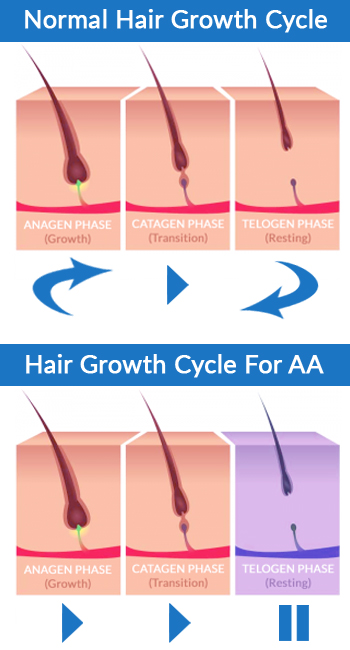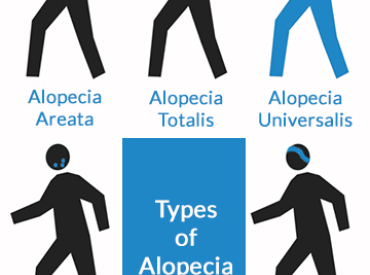Systematic Review Shows Naltrexone May Treat Alopecia Areata
More research coming out of America shows that low doses of naltrexone may treat Alopecia Areata, the autoimmune disorder which can cause hair loss in various hair-bearing areas of the scalp and body.
Low-dose naltrexone (LDN) was named in January 2018 by Natasha Atanaskova Mesinkovska of the Department of Dermatology at the University of California, as an emerging treatment for Alopecia Areata.
Researchers from the dermatology departments at both the University of California and Howard University Hospital in Washington, DC, then carried out a systematic review of naltrexone's current and potential dermatological applications, in April the same year. The results appear to back this earlier assertion regarding autoimmune hair loss as well as discovering LDN may also be a potential solution for Lichen Planopilaris and scarring alopecia, also known as Cicatricial Alopecia.
Their findings were published in the JAMA Dermatology medical journal on 28th November 2018.
Naltrexone was initially authorised in 1984 to treat drug and alcohol addiction. Although there was little substantive research into other areas in which it may be helpful, anecdotal reports from clinicians have repeatedly been submitted. These include linking the medication to improvements in conditions including multiple sclerosis, Crohn's disease, cancer, HIV infection and AIDS.
In the study paper, its authors state the reason for wanting to review current literature regarding naltrexone treatment for dermatologic conditions, as follows:
"Dermatology is encountering increasing rates of autoimmune disease manifesting in primary skin conditions that are difficult to treat without a risk of immunosuppression. Naltrexone is an orally active opioid antagonist that influences a variety of systemic pathways, including the immune system, in low doses of 1.5 to 4.0 mg/d. This phenomenon has piqued the interest of researchers and practitioners in regard to low-dose naltrexone’s potential in the treatment of several autoimmune conditions."
Using the PubMed database, searches were carried out into articles regarding dermatologic studies published between 1971 and April 2018 that contained specific search terms. These included 'naltrexone' or 'low-dose naltrexone' and 'dermatology', 'skin', 'hair' or 'nails'. The team gathered 1,037 articles in total, of which 22 were suitable for review.
After thorough consideration, it was concluded that the research to date suggests low-dose naltrexone "is safe and effective in the treatment of Hailey-Hailey disease and lichen planopilaris and both low- and high-dose naltrexone successfully treat pruritus attributable to various pathologic conditions; however, more adverse effects occurred in those taking high doses. Low-dose naltrexone has the potential for the treatment of chronic inflammatory skin conditions".
It was, however, also noted that further evidence would be needed regarding dosing and guidelines for long-term treatment before this could be put into wider practice.
"Naltrexone, particularly in low doses, has the potential to treat an array of primary skin lesions through inflammatory and immune-cell regulation and skin regeneration," state the study's authors. "Potential future uses include the treatment of diabetic wounds, bullous diseases, scarring alopecia, alopecia areata, and psoriasis."
 Alopecia Areata (AA) is a term used to refer to both a group of hair loss conditions caused by autoimmune disease, and its mildest phenotype. This presents as patchy hair loss to the scalp only and can range from a single, small £2 coin-sized bald spot, to multiple rounded bald patches which may join up to form larger areas of shedding. Alopecia Barbae is similar in appearance but only affects beard hair.
Alopecia Areata (AA) is a term used to refer to both a group of hair loss conditions caused by autoimmune disease, and its mildest phenotype. This presents as patchy hair loss to the scalp only and can range from a single, small £2 coin-sized bald spot, to multiple rounded bald patches which may join up to form larger areas of shedding. Alopecia Barbae is similar in appearance but only affects beard hair.
The two more extensive iterations are Alopecia Totalis and Alopecia Universalis which result in baldness of the whole head, and from head to toe, respectively. Although Alopecia Areata Treatment exists for adults with the mildest scalp-only form, where hair outside the scalp region is also affected, or for children with any version, options become fewer and less effective.
Typically in all instances the onset is sudden and men, women and children can all be affected, regardless of race or hair type. Hair fall is understood to occur when a trigger, often suggested to be shock, sudden trauma or allergies, disrupts the hair growth cycle, pushing it prematurely into the resting 'telogen' phase, where hair is shed. How long it remains in this dormant state cannot be predicted though in the majority of Alopecia Areata (scalp-only) cases, normal hair regrowth should resume within 12 months.
Given the psychological toll this type of hair loss can have on people, the FDA has granted 'fast track' status to a number of treatments currently in development, with a view to approving treatments for all forms of Alopecia Areata within the next few years.
Low-dose naltrexone (LDN) was named in January 2018 by Natasha Atanaskova Mesinkovska of the Department of Dermatology at the University of California, as an emerging treatment for Alopecia Areata.
Researchers from the dermatology departments at both the University of California and Howard University Hospital in Washington, DC, then carried out a systematic review of naltrexone's current and potential dermatological applications, in April the same year. The results appear to back this earlier assertion regarding autoimmune hair loss as well as discovering LDN may also be a potential solution for Lichen Planopilaris and scarring alopecia, also known as Cicatricial Alopecia.
Their findings were published in the JAMA Dermatology medical journal on 28th November 2018.
Potential treatment for chronic inflammatory skin conditions
Naltrexone was initially authorised in 1984 to treat drug and alcohol addiction. Although there was little substantive research into other areas in which it may be helpful, anecdotal reports from clinicians have repeatedly been submitted. These include linking the medication to improvements in conditions including multiple sclerosis, Crohn's disease, cancer, HIV infection and AIDS.
In the study paper, its authors state the reason for wanting to review current literature regarding naltrexone treatment for dermatologic conditions, as follows:
"Dermatology is encountering increasing rates of autoimmune disease manifesting in primary skin conditions that are difficult to treat without a risk of immunosuppression. Naltrexone is an orally active opioid antagonist that influences a variety of systemic pathways, including the immune system, in low doses of 1.5 to 4.0 mg/d. This phenomenon has piqued the interest of researchers and practitioners in regard to low-dose naltrexone’s potential in the treatment of several autoimmune conditions."
Using the PubMed database, searches were carried out into articles regarding dermatologic studies published between 1971 and April 2018 that contained specific search terms. These included 'naltrexone' or 'low-dose naltrexone' and 'dermatology', 'skin', 'hair' or 'nails'. The team gathered 1,037 articles in total, of which 22 were suitable for review.
After thorough consideration, it was concluded that the research to date suggests low-dose naltrexone "is safe and effective in the treatment of Hailey-Hailey disease and lichen planopilaris and both low- and high-dose naltrexone successfully treat pruritus attributable to various pathologic conditions; however, more adverse effects occurred in those taking high doses. Low-dose naltrexone has the potential for the treatment of chronic inflammatory skin conditions".
It was, however, also noted that further evidence would be needed regarding dosing and guidelines for long-term treatment before this could be put into wider practice.
"Naltrexone, particularly in low doses, has the potential to treat an array of primary skin lesions through inflammatory and immune-cell regulation and skin regeneration," state the study's authors. "Potential future uses include the treatment of diabetic wounds, bullous diseases, scarring alopecia, alopecia areata, and psoriasis."
About Alopecia Areata
The two more extensive iterations are Alopecia Totalis and Alopecia Universalis which result in baldness of the whole head, and from head to toe, respectively. Although Alopecia Areata Treatment exists for adults with the mildest scalp-only form, where hair outside the scalp region is also affected, or for children with any version, options become fewer and less effective.
Typically in all instances the onset is sudden and men, women and children can all be affected, regardless of race or hair type. Hair fall is understood to occur when a trigger, often suggested to be shock, sudden trauma or allergies, disrupts the hair growth cycle, pushing it prematurely into the resting 'telogen' phase, where hair is shed. How long it remains in this dormant state cannot be predicted though in the majority of Alopecia Areata (scalp-only) cases, normal hair regrowth should resume within 12 months.
Given the psychological toll this type of hair loss can have on people, the FDA has granted 'fast track' status to a number of treatments currently in development, with a view to approving treatments for all forms of Alopecia Areata within the next few years.

The Belgravia Centre
The Belgravia Centre is a world-renowned group of a hair loss clinic in Central London, UK. If you are worried about hair loss you can arrange a free consultation with a hair loss expert or complete our Online Consultation from anywhere in the world for home-use treatment.
View our Hair Loss Success Stories, which includes the world's largest gallery of hair growth photos and demonstrates the level of success that so many of Belgravia's patients achieve.

